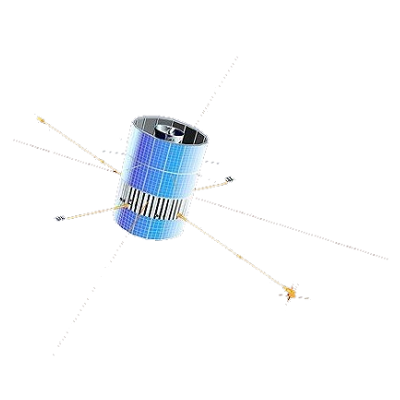IMP Charged Particle Measurement Experiment
at Fundamental Technologies
IMP8 Mission Overview
| IMP8 (IMP J/ Explorer 50), the last satellite of the IMP series, was launched by NASA on Oct. 26, 1973. The IMP 8 spacecraft was designed to measure magnetic fields, plasmas, and energetic charged particles of the Earth's magnetotail and magnetosheath and the near-Earth solar wind. IMP 8 has lived long past its life expectancy of 10 years of operation; after over 30 years of operation in space, it is still functioning to this day (January 2007). |
 |
IMP 8 is a drum-shape spacecraft 135.6 cm across and 157.4 cm high. It originally had an elliptical orbit with apogee and perigee distances of about 45 and 25 Earth radii, respectively, but its eccentricity has decreased since it was launched. It is now about 160,000 miles away from Earth. The spacecraft has an inclination which has varied between 0 deg and 55 deg in a period of several years. The spacecraft spin axis is normal to the ecliptic plane, and the spin rate is 23 rpm. The spacecraft takes 12.5 days to orbit around the Earth--seven to eight days are spent in the solar wind, with the rest of the time in the magnetosheath and magnetosphere.
The battery of the IMP 8 spacecraft died long ago, but since it spends most of its time in the sunlight, the spacecraft has always had enough power from its solar arrays for data transmission to the Earth. Convolutionally encoded PCM (pulse code modulated) data are transmitted at VHF frequency (137.98MHz) at the total rate of 3200 bits/s. Since the spacecraft has no onboard recorder, it transmits data all the time. Therefore it is important that NASA has a worldwide VHF telemetry coverage ground network to cover the transmission.
Return to IMP
Table of Contents Page.
Return to Fundamental
Technologies Home Page.
Updated 8/8/19, Cameron Crane
QUICK FACTS
Destination: The IMP-8 spacecraft spends roughly half of its 12-day orbit in solar winds, with the other half spent studying the magnetosphere and magnetosheath of Earth.
Orbit: The IMP-8 spacecraft orbits in a geocentric elliptical orbit with an inclination varying from 0 to 55 degrees.


